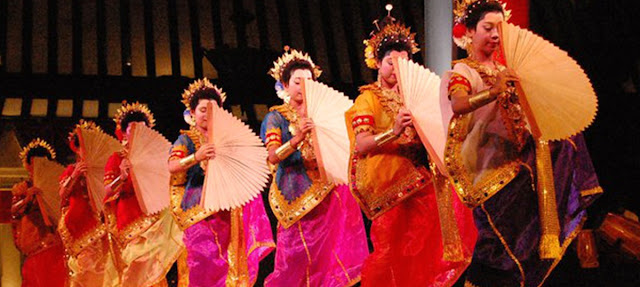 |
| Source:Indonesia.travel |
From the enchanting waters overlooking the capital city of Makassar up to the highland of Toraja, South Sulawesi is a land blessed with fascinating splendors. While nature provides the magnificent settings, the indigenous people present an equally fascinating culture. One of the well preserved cultural traditions of South Sulawesi takes shape in the Pakarena Dance.
Originated from the ancient Sultanate of Gowa in today’s Gowa regency, Pakarena is believed to be derived from the word “karena” which means “to Play” in the local language. The dance seems to have been spread widely throughout the area, thus many variations are found based on location. Among these are the Pakarena Gantarang, Pakarena Balla Bulo, and Pakarena Bontobangung. The dance also varies according to the type of performance. Among them are the Pakarena Royong which is strictly performed during ritual ceremonies, and the Pakarena Bone Ballawhich can be performed at anytime.
Pakarena expresses the elegance of the Makassar ethnic women symbolizing their politeness, loyalty, obedience and respect towards their spouses. The dance consists of 12 parts that have their own distinct meanings although they are difficult to differentiate by untrained eyes, since patterns appear to be similar. Both the seated position which commences and ends the performance, as well as the clock wise movement represent the cycle of human life. While the ascending and descending movements symbolize the wheel of life; sometimes we are at the top, while at other times we are down. In all choreographies, the dancers hold and play the distinct traditional fan.
The dance has a unique rule: dancers must not open their eyes too wide and their feet must not be lifted too high.
There are no clear rules on the number of performers; however the Pakarena Balla Bulo is only played in odd numbers of 9, 7, or 5. The dance is accompanied by vibrant music played by an ensemble of Gendang percussions, Kanong-kanong, gong, kancing-kancing, and pui-pui.
For the performance, dancers wear colorful traditional costumes consisting of: the hand woven Baju Pahang, the finely woven lipa’ sabe’ (traditional Silk Sarong of South Sulawesi), complemented with elaborate gold accessories of South Sulawesi.
There are no official records indicating when was the first time the dance appeared. However, it is known that Pakarena was an official royal dance during the reign of Sultan Hasanudin, the 16th Sultan of Gowa. The dance is also believed to have been influenced by the mother of the Sultan, I Li’mokantu. Some Makassarese believe that the Pakarena Dance may have its origin in the legend of the parting between boting langi (inhabitants of heaven) and the inhabitants of lino (earth).
The legend goes that when the boting langi departed to heaven, they taught the people on earth how to survive. These include how to grow crops, farming, and hunting. These lessons are subsequently expressed through the movements of the hands, feet, and body. These then evolved into the choreography of the Pakarena Dance, which the people would perform during rituals to express their gratitude to God. (Indonesia.travel)





No comments:
Post a Comment
your comments are now being moderated